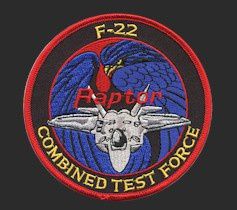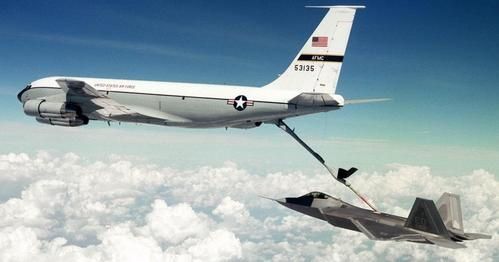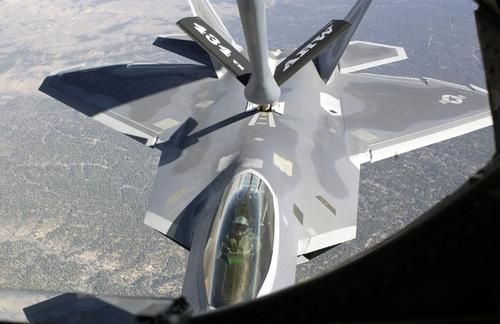




![]()

The F-22 program is developing the next-generation air superiority fighter for the United States Air Force to counter emerging worldwide threats. The F-22 Raptor is designed to ensure that America's armed forces retain air dominance. This means complete control of the airspace over an area of conflict, thereby allowing freedom to attack and freedom from attack at all times and places for the full spectrum of military operations. Air dominance provides the ability to defend our forces from enemy attack and to attack adversary forces without hindrance from enemy aircraft.
During the initial phases of deployment into an area of conflict, the first aircraft to arrive are the most vulnerable because they face the entire warfighting capability of an adversary. The F-22's state-of-the-art technology, advanced tactics, and skilled aircrew will ensure air dominance from the outset of such situations. It is designed to penetrate enemy airspace and achieve a first-look, first-kill capability against multiple targets. The F-22 is characterized by a low-observable, highly maneuverable airframe; advanced integrated avionics; and aerodynamic performance allowing supersonic cruise without afterburner.
The F-22 is an air dominance fighter with much-improved capability over current Air Force aircraft. It is widely regarded as the most advanced fighter in the world, combining a revolutionary leap in technology and capability with reduced support requirements and maintenance costs. It will replace the F-15 as America's front-line, air superiority fighter, with deliveries to operational units in 2005.
From the inception of the battle, the F-22's primary objective will be to establish absolute control of the skies through the conduct of counterair operations. The fighter also has an inherent precision ground attack capability. The F-22 is capable of carrying existing and planned medium and short range air-to-air missiles in internal bays. The F-22 will also have an internal 20-mm cannon and provisions for carrying precision ground attack weapons.
The F-22 Raptor is being developed to counter lethal threats posed by advanced surface-to-air missile systems and next generation fighters equipped with launch-and-leave missiles. The Air Force faces two challenges to providing air dominance with its current fleet of fighter aircraft. First, other nations continuously improve their aerial warfare capability by fielding newer, faster, more maneuverable aircraft, such as the MiG-29, Su-35, Rafale, Gripen, and Eurofighter. Second, potential adversaries have added sophisticated air defenses built around surface-to-air missiles that can target conventional aircraft more accurately and at greater distances than in the past. The F-22 has the stealth, speed, and maneuverability to overcome these challenges and ensure air dominance over any battlefield.
The F-22's combination of stealth, integrated avionics, maneuverability and supercruise will give Raptor pilots a first-look, first-shot, first-kill capability against the aircraft of any potential enemy. The F-22 is designed to provide not just air superiority, but air dominance, winning quickly and decisively with few US casualties. The Raptor also has an inherent air-to-ground capability.
The F-22 will provide a first-look, first-shot, first-kill capability through the use of reduced observables and advanced sensors. To decrease the reaction time of enemy threats, increased supersonic cruise, and maneuverability goals have been set. The F-22's avionics suite is a highly integrated system maximizing performance to allow the pilot to concentrate on the mission, rather than on managing the sensors as in current fighters. To improve operations from battle-damaged runways, the F-22 offers significantly reduced takeoff and landing distances, as compared to today's frontline fighters. A greatly increased combat radius, using internal fuel only, will give F-22 pilots the capability to engage the enemy over his territory and support long-range air-to-ground assets such as the F-15E. The F-22 will also bring a precision ground attack capability to the battlefield. In addition to greater lethality and survivability, the F-22 design calls for higher reliability, maintainability, and sortie generation rates than the aircraft it will replace. The design goal for all areas is a 100 percent improvement over the F-15 weapon system.
The F-22 is 62 feet, 1 inch long, it has a wingspan of 44 feet 6 inches, and stands 16 feet, 5 inches tall. The F-22A is a single seat aircraft.
"Agility" is the ability of the F-22 pilot to point and shoot with his aircraft, pirouetting, and facing the enemy with his weapons at all speeds. The F-22 pilot can maintain control of the aircraft at speeds as low as that of a Piper Cub or at very high supersonic speeds. Because of the F-22's sophisticated aero-design and high thrust-to-weight ratio, it can easily outmaneuver all current and projected threat aircraft, both at medium and high altitudes.
"Supercruise" is the term given to the capability of sustaining supersonic speeds for long periods of time. Conventional fighters, while capable of supersonic flight, can only sustain these speeds for relatively short periods as the result of excessively high fuel consumption using afterburner. The F-22's engines produce more thrust than any current fighter engine, especially in military (non-afterburner) power. Called "supercruise," this characteristic allows the F-22 to efficiently cruise at supersonic airspeeds without using afterburners. The F-22's engine is expected to be the first to provide the ability to fly faster than the speed of sound for an extended period of time without the high fuel consumption characteristic of aircraft that use afterburners to achieve supersonic speeds. It is expected to provide high performance and high fuel efficiency at slower speeds as well. This capability greatly expands the F-22's operating envelope in both speed and range over current fighters that must use afterburner to operate at supersonic speeds. The F-22 can cruise supersonically without afterburner and, therefore, can sustain these speeds for long periods. The enemy must react to any intruder and that reaction time to detect, aim weapons and launch, is severely reduced when the intruder is moving fast. At supercruise speeds, the F-22 (and its pilot) becomes less vulnerable to enemy missiles and aircraft simply because they cannot react fast enough.
The industry team of Lockheed Martin and Boeing is working with the U.S. Air Force and Pratt & Whitneyto develop the F-22 to replace the F-15 as America's front line air dominance fighter. The Critical Design Review (CDR) of the F-22 and the Initial Production Readiness Review (IPRR) of the F119 engine were completed in February 1995. The Air Force confirmed that the program was ready to proceed to fabrication and assembly of EMD aircraft. First flight of an EMD aircraft took place in September 1997. Low-rate initial production began in 1999. The F-22A Raptor achieved Initial Operational Capability [IOC] on 15 December 2005.
Prior to its selection as winner of what was then known as the Advanced Tactical Fighter (ATF) competition, the F-22 team conducted a 54-month demonstration/validation (dem/val) program. The effort involved the design, construction, and flight testing of two YF-22 prototype aircraft. The dem/val phase of the program was completed in December 1990. Two prototype engine designs, the Pratt & Whitney YF119-PW-100 and the General Electric YF120-GE-100, also were developed and tested during the program. The Pratt & Whitney F119 was selected by the Air Force to power the F-22. Much of the dem/val work was performed at Lockheed (now Lockheed Martin) in Burbank, Calif.; at General Dynamics (now Lockheed Martin Tactical Aircraft Systems) in Fort Worth, Texas, at Boeing in Seattle, Wash. The prototypes were assembled in Lockheed's Palmdale, CA, facility and made their maiden flight from there. Since that time, Lockheed Martin's program management and aircraft assembly operations have moved to Marietta, GA., for the EMD and production phases.
The fast, agile, and stealthy F-22 began to take over the air dominance role first with Air Combat Command. Once testing and evaluations were successfully completed on the F/A-22 Raptor, it made its debut into the Air Force arsenal in 2005 as a replacement for the F-15 Eagle. The F/A-22's operational utility was tested and evaluated at Air Combat Command's 422nd Test and Evaluation Squadron at Nellis Air Force Base, Nev.



| Propulsion | two Pratt & Whitney F119-PW-100 engines |
| Thrust | 35,000 lbst |
| Length | 62.08 feet, 18.90 meters |
| Height | 16.67 feet, 5.08 meters |
| Wingspan | 44.5 feet, 13.56 meters |
| Wing Area | 840 square feet |
| Horizontal Tailspan | 29 feet, 8.84 meters |
| Empty Weight | 31,670 lb (14,365 kg) |
| Maximum Takeoff Weight | 60,000 lb (27,000 kg) |
| Maximum External Stores | 5,000 lb (2,270 kg) |
| Ceiling | 60,000 feet The F-22 and other fighters can reach this altitude, but only the F-22 can perform tactical maneuvers at this level, which is about twice the altitude at which other jets can perform tactical maneuvers. |
| Speed | Mach 1.8 (supercruise: Mach 1.5) |
| G Limit | +9 G |
| Crew | one pilot |




US Air Force F-22 Raptor video
YF 22
F-22 RAPTOR DEBUT
US Air Force Recruiting Ad
U.S. Air Force
























/idata%2F0396584%2FKOREA%2F71910_korea_MIA1_800.JPG)
/idata%2F0396584%2FU.S.ARMY-POST-WW2%2Fphot4901a.jpg)
/idata%2F0396584%2FDRAWINGS-UNIFORMS-WW2%2F30-451-09b-2.jpg)
/idata%2F0396584%2FP-40%2F44FS000.jpg)
/idata%2F0396584%2FGERMAN-U-BOAT%2FBundesarchiv_Bild_101II-MW-1031-28-_Lorient-_U-31.jpg)
/idata%2F0396584%2FSOVIET-ARMY-WW2%2F1.jpg)




